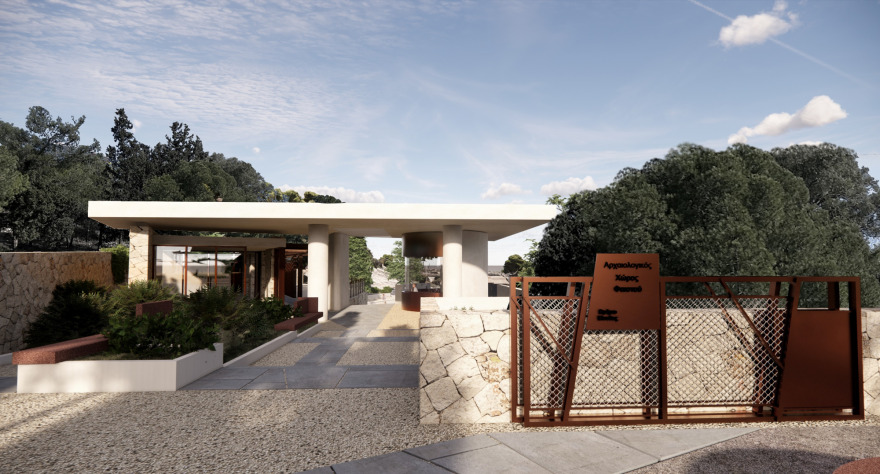The significant archaeological site of Phaistos will acquire a new, modern appearance through a series of interventions by the Ministry of Culture, aimed at upgrading the visitor service infrastructure. The project, with a budget of €2.5 million, funded by the Regional Operational Program “Crete” under the NSRF 2021-2027, includes a new ticket office and shop, the addition of pathways for disabled visitors and people with mobility issues, and new signage and information.

Photorealistic depiction of the amphitheatrical gathering spaces
The positioning of the old “Xenia” hotel, which today belongs to the Municipality of Phaistos, along with the associated works, determined, until now, access, infrastructure organization, and visitor touring at Phaistos. With the implementation of the Unified Management Plan, the necessary slopes for the movement of disabled visitors are ensured, based on the level of the new building infrastructure, in relation to the parking area and the existing viewing platform for disabled visitors above the Upper West Court of the Palace. The new complex brings together all the infrastructure, creating a unified central area for visitor services and better infrastructure functionality, such as the ticket office, the shop, restrooms, and the atrium in between.
Photorealistic depiction of the new entrance-exit
The project includes the new positioning of the reception and the entrance/exit, new public service infrastructure (ticket office, shop, restrooms—all on the ground floor), right next to the existing entrance, the creation of a new outdoor gathering space near the entrance with steps and a view of the palace, improved visitor pathways with two routes, one to the south for the general public and one to the north for people with disabilities leading to the Upper West Court, with a shared return route for all visitors, and the creation of new information and viewing points. These spaces blend into the landscape and help alleviate overcrowding at the monument, providing relaxation and information for visitors.

Photorealistic depiction of the new visitor pathway
“Our priority is the improvement of services at archaeological sites, with a focus on accessibility for disabled and mobility-impaired visitors. The Minoan Palace of Phaistos, along with the archaeological site of Knossos, is one of the most important cultural sites in Crete, with high visitor numbers. It is currently being serially listed, along with six Minoan palaces, for inclusion in UNESCO’s World Heritage List. Our goal is to create a modern, functional, and aesthetically pleasing central and better-managed space through the proposed interventions. I should also mention that, in addition to the protection and promotion of Phaistos, a management plan for the archaeological site is being developed as part of the National Strategic Plan to address the impacts of Climate Change on Cultural Heritage. This plan, developed by the Ministry of Culture in scientific collaboration with the National and Kapodistrian University of Athens and the National Research Foundation, aims to safeguard the site against the climate crisis. The entire set of projects planned for the archaeological site of Phaistos is funded by the Operational Program of the Region of Crete under the NSRF 2021-2027, for which I express my thanks,” said the Minister of Culture, Lina Mendoni.

Photorealistic depiction of the new ticket office and accessible pathway
The hill of the palace has been continuously inhabited from the 4th millennium BC to the 2nd century BC. The Old Palace was built between 1900 and 1700 BC on top of the hill. By the end of the Protopalatial period, it covered an area of about 9,000 square meters. It was destroyed twice by earthquakes and rebuilt. The architectural remains of the three successive building phases are well-preserved in the southwestern part, where walls up to 6 meters high can be seen, and part of the Old Palace is roofed. After its final destruction (around 1700 BC), the New Palace was built further east and on a higher level, and it was inhabited until the mid-15th century BC, when it was destroyed. The New Palace was smaller but more monumental than the Old Palace and had all the characteristics of a Minoan palace, such as a rectangular central courtyard with wings on four sides, covering a large area (~8,000 square meters), a ceremonial road linking the palace to the city, a monumental entrance with stairs, luxurious halls, lustral basins, royal apartments, storerooms, and workshops, and grand staircases. The city surrounding it continued to be inhabited and flourished particularly in the Geometric (810-700 BC) and Hellenistic (323-67 BC) periods. Around 150 BC, the city of Phaistos was permanently destroyed. Excavations of the palace began in 1900 by Italian archaeologists Federico Halbherr and Luigi Pernier, who discovered the famous Phaistos Disc in 1908. By 1909, the excavation of the New Palace was completed, with some work continuing until 1914 and later from 1928 to 1932. After World War II, excavations resumed from 1950 to 1971, during which the Old Palace and parts of the prehistoric and historical city were uncovered.
Ask me anything
Explore related questions





